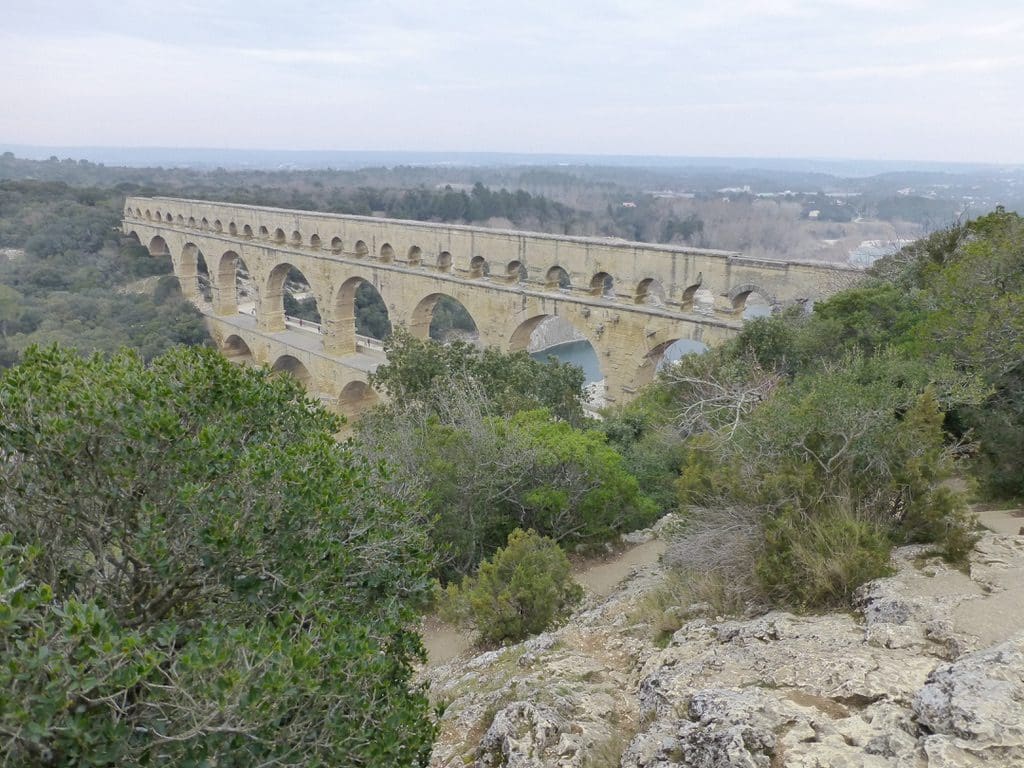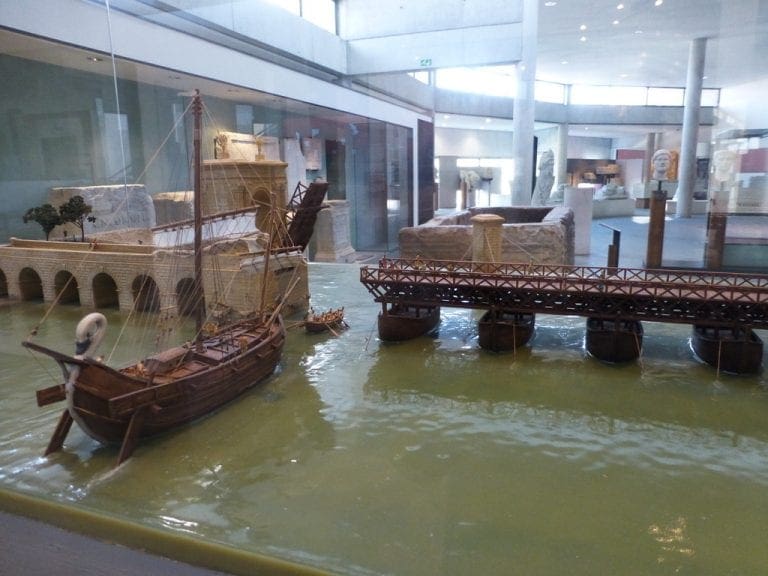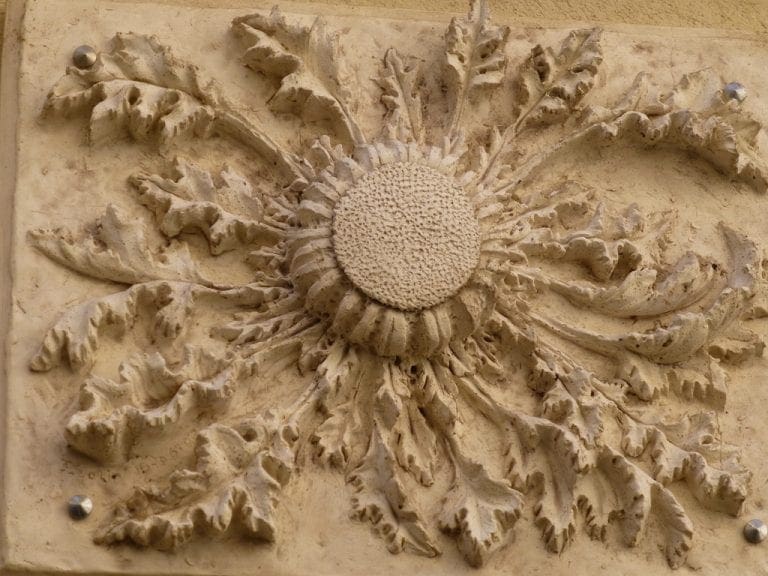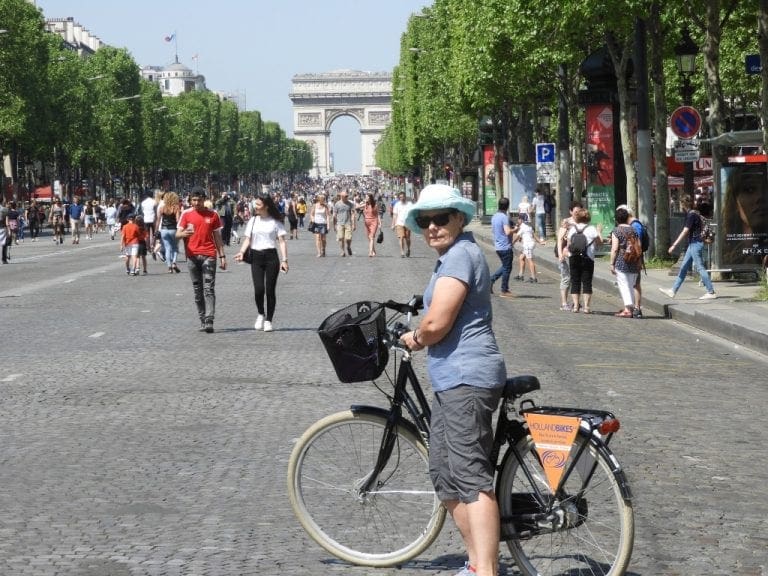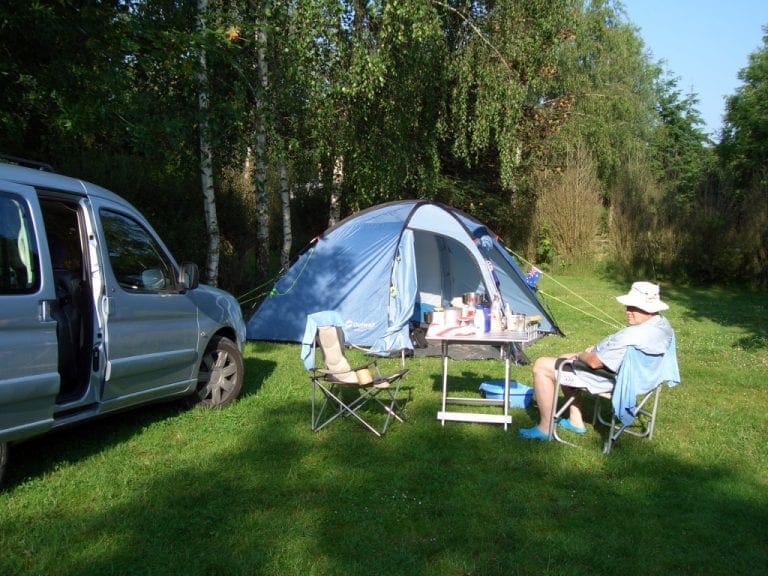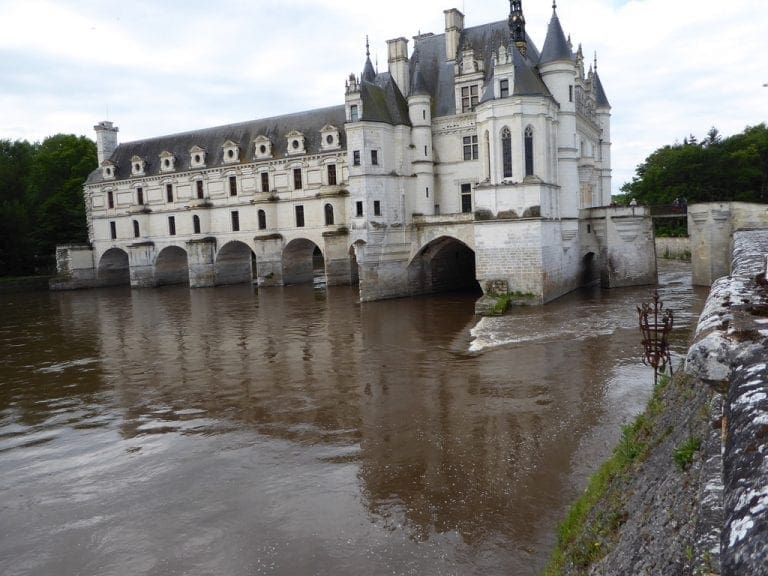France 2013 – week 4 – Collias
23 Feb 2013. Saturday. Day 22. Change over day. -5C and a good layer of ice on the car – took 5 mins to melt it off. Getting the two suitcases down the narrow spiral stairs made me thankful for all the gym exercises. I appalled the young lady in the bakery by asking to take photos of her bread. I was actually very interested in the prices – very exact €1.02 or €1.01. We would never do that, would we? Always $0.99. The bakery is also very insistent on getting that 2 cents. They never say – ‘oh make it a euro’. There are so many different types of bread which to my unpracticed eye look like ‘French Sticks’ or balls. We really like the cereal loaf sold next door. Some days it has a tail to make it look like a fish – same price. In Isle-sur-la-Sorgue, we have 4 bakeries within 50 metres. Yesterday, I found out that the choir web-site has had a major problem with all the practice music files disappearing. Hopefully, we can restore it from what I have, by chance, with me.

Our next village is Collias (pronounces Co-lee-ass, not Co-lie-ass – no hint of a lie) is just 60 km from Isle-sur-la-Sorgue. It is like being in another country. We have change Regions and Departments (from 84 to 30). On the way, the girl in the GPS directed us through Avignon – through the most traffic I’ve seen so far with locals doing their Saturday shopping. Not actually over La Pont but over another pont on which, I can assure you, no one was dancing because of the gentle Arctic zephyr that kept trying to nudge the car off the road with its light puffs. The house we are in is built from the stones of a ruined castle that was in Collias. We have a cold unpleasant wind today. We decided to do nothing except move and eat. Finding something to eat was a touch difficult. The first two restaurants we went to were shut for the winter – as, it turns out, are most. We doggedly drove looking for something open and found the most delightful Auberge des Escaravats at Remoulins. We had a 4 course meal and a very nice bottle of local Viognier. Helen had fish soup with bread, aioli and the strongest garlic I’ve ever tasted. Extremely good. My Terrine Forrester was ok. For the next course, I had chook with a garlic, tomato and basil sauce. That sauce is close to the best thing I’ve tasted. Helen had rabbit and rice. The place had only one other couple and we were served by a very nice older lady who I suspect was the owner. Very soft music that sounded like it came form the kitchen and was at a level where I was always thinking it could be a bit louder. Isn’t that a change! Cheese followed. Four from the plate of 10 were amongst the best I’ve had. Then a desert. Mine turned out to be extremely alcoholic. Which happens when you don’t understand the language. We drove back to Collias and arrived right on the 3 pm book-in time with our new landlady. Collias has very very very narrow streets. All looked to be one way – with no entry signs on every street – no matter where you were. Locals appeared to take no notice so we did the same. Our landlady is extremely friendly and chatted. I am always impressed with how similar French and Australians are. Very similar sense of humour. I spent the afternoon and evening repairing the choir’s music holdings on its web-site.
24 Feb 2013. Sunday. Day 23. A genuine day off. A cold, grey overcast day with a ‘Little Mistral’ or gentle zephyr blowing off the Arctic. Feels like -5C. We are in a very tiny village here at Collias. Just the one bakery for the village. It is about 200m uphill from our very nice apartment. On our walk there, we came across two cars that had been broken into overnight. A little old lady who was passing was almost in tears about what had become of her village that this could happen. It also confirms all the advice we have had about ‘nothing left in the vehicle – nothing, nothing, NOTHING’. I was puzzled yesterday by all the ‘no entry’ signs. Next to the bakery is an excellent example. The road says ‘no entry’ – yet there are arrows directing you to a hotel and wine shop down there. This apartment, like all the others so far, has been stocked with appointments from IKEA.
As we were leaving yesterday in our chat with our landlord Eric, he told us of the system of school holidays across France. There are 3 zones for school holidays – 2 weeks per zone – that spreads the holidays over 6 weeks, which is good for tourism, n’est pas? The order is rotated. This year, the south gets to go first. So, he had just returned from having first go at the snow. Our landlady this week was bemoaning the recession in France and the number of resultant suicides.
As it turned out, not much of a day off for me. I spent much of it wrestling with the choir’s web site. Dragged out because of the extremely slow upload speeds and limits on my software that allowed only 6 batches of files to be uploaded at a time. Some were still running when I got up the next day! I may have melted the local wifi network. Which of course raises the benefits of cable over wifi. Local wifi looks great for wide easy reach. However, if you want to do something serious, like upload a Gigabyte of files, it falls way short.

25 Feb 2013. Monday. Day 24. In Collias, the wind has stopped and the temperature struggled up to about 10C from a negative start. We headed off to Arles (pron Arl) for a Roman Day. Arles was the major city in the Provence. Essentially founded by Julius Caesar when he retired his 6th legion here as a put down for Marseille for siding with Pompey in the civil war. Augustus threw money at the town/city, had a few roads and aqueducts built and built an arena (to seat 20,000), a theatre to seat (10,000), a circus (to race horses).
Roman Arles population was 100,000. Present day, it has less than half that. We began at the excellent ‘Ancient History Museum’ which has several excellent models to show what things did look like. Given the huge quantity of material they must have, they have just enough out on display and displayed well, to make it very interesting. Extremely impressive. i-am-barbegal-roman-watermill We then wandered to the Roman Arena – which is nearing the end of a major restoration. What is currently the ground level (on which bullfights are held) would have been two levels underground in Roman times.
From the 8th century in medieval times, the Arena became a fortified town with 200 houses packed in and watchtowers added. It later became a stone quarry and was severely bombed during WW2. A lot to restore. i-am-roman-bridge-across-rhone From there to the remains of the Forum which is now the town square. Just one pillar of the Forum remains.
Around the corner is St Trophime Church – named after a 3rd century bishop and still a major stop on the Santiago de Compostela pilgrimage route. Last stop was the Theatre – much in need of restoration and just a shadow of its former self. It was 4 tiers of seating – now just 1 1/2 tiers. All these Roman antiquities are within a few metres of each other and did dominate the town with its bridge over the Rhone.
On our way to Arles, I had a major run in with motorway tolls. I have not yet worked out what toll booth to approach. I was certainly at the wrong booth today. And the automatic machine had eaten my motorway ticket. After much frustration, I pushed the help button. Eventually, a booth attendant arrived to take my €2.20. Beats me where I have to line up.
Almost home, we found a place with cheap fuel attached to a big supermarket. In this part of France, we have stepped away from the small village market based economy of the Luberon and stepped in supermarket economy with plastic wrapped cheese. I was very surprised to see rabbit and duck in the cold shelves next to the chook. The cheese was very good though. Cheap fuel too. Our average so far is 6.29 l/100 km – which is not bad given chugging twice up Ventoux and all those little winding hill-top towns. Not bad. But, more than the 4.9 advertised.
26 Feb 2013. Tuesday. Day 25. Weather similar to yesterday. Cold early and struggling up to 10C by early afternoon. There is a small 3cm lip leading into the toilet here. This morning, in the dark, I tripped on it. The ironing board that was lurking behind the door leapt out and enfolded me – blundering around in the dark. Quite humorous. We were both a bit tired after our day yesterday and had another full day off. I even had a kip after lunch. Speaking of which, Helen had cooked a chook yesterday and we had an excellent three course meal – and a bottle and a half of wine. That might explain the kip after lunch.
27 Feb 2013. Wednesday. Day 26. Weather similar to yesterday but getting warmer in the middle of the day. An excellent day. We went to Uzes, the local bigger village/town, mainly to have lunch and see what the local market mid-week had to offer (quiet). i-am-uzes We did discover a very good/excellent lunch spot.
Les Terroirs in the market square at Uzes in a very sunny spot. Initially, we were disappointed because our chosen lunch spot was closed – as so many are. Terroirs was on the edge of the market square and clearly the energy came from there. I was not disappointed. We arrived just before noon and the ‘drinks’ crowd were just leaving to be replaced by the ‘eating’ crowd. Very thoughtful blankets placed over chairs just in case the sun was not warm enough. In summer, the restaurant takes up half the square. Madame, the owner, kept patting me as she went past. Monsieur swiftly changed to English when we fumbled with the menu – there was even an English menu produced later – and gently suggested ‘I move my serviette’ so he could put my meal down. We had a French couple on my left and a trio of American/German on my right. We had a very long talk with the American/German who now live locally. Nice people. In their renovation, they had just this week found an ice house from about 1600 – the time of Henry IV and Catherine de Medici. The French couple on the other side were trying to keep up. This restaurant must do a great deal for the town. Helen had the very thin strips of raw beef. I had the foie gras followed by the to die for ‘Terroir’ desert – caramel, honey, nuts, whipped cream. Excellent. Helen has decided that she wants no more of hill-top towns, museums, or Romans. More lunches like those at Terroirs at Uzes are what is required. There is no doubt that we liked the village/town of Uzes.
On our way to Uzes, we called into a Carrefour Supermarket. Huge. The biggest supermarket I been into outside of the US. And this is outside of a little town/village in the middle of nowhere. Very well stocked. Frantically busy staff restocking shelves faster than a dog can hear. Huge selections of fresh food – fish, cheese, butcher, charcutier, etc. An isle of wine and one of spirits, half an isle for casks. One bay for champagnes – most less than €20.
I should write a little about restoration of buildings. Almost every house in every village is undergoing or has undergone some form of restoration. Most of the buildings in most of the towns are under some form of preservation order which makes DIY impossible without significant applications and much form filling. You cannot wield an angle grinder here without a permit. Restoration with preservation looks like the standard. (Or, leave the restricted outside alone, and do over the inside without the permit!)
I do appear to get by quite well without any French. I laugh and smile and get patted. It would be good to know what is being said. However, I am far too slow. For example, when I was lugging a case down the stairs at Sorgue, a friendly neighbour, seeing the size of the case, asked if we were staying long in France. I had loaded that case into the car, walked up 4 flights of stairs, lugged the second case down those same stairs and loaded into the car BEFORE I had translated that simple question. Doh!
28 Feb 2013. Thursday. Day 27. Cold in the morning (negative) to 14C mid-day. Extremely pleasant. I have come to really like my quick walk up the hill to the distant bakery 200m away, with my glasses fogging up when I enter. We headed of to the tourist mecca of Les Baux (i-am-les-baux) via a ruined 18th century windmill and a Roman aqueduct. We failed to find Barbegal i-am-barbegal-roman-watermill though we must have driven over it. Having read about Les Baux and driven to it, we decided not to visit it after all.
Instead, we drove up the winding road that climbs above it. (Les Baux was a stronghold in the south of France for a very long time. It was eventually destroyed in the 1632 by d’Artagnan’s villain Richelieu as the Huguenot wars hotted up.) Great views from the top. We were looking for a lunch spot and noticed the nearby ruins of Glanum – which turned out to be yet another Roman ruined city on the via Domitia. Van Gough painted the very same olive grove that we had lunch in. (Well, maybe not the same trees.) Headed home to try the bottle of Cremant I had bought yesterday (Cremant is what Champagne is called if it does not come from Champagne – we call it ‘sparkling white’) – better than any Oz bubbly I’ve tasted but not as good as Champagne. Change of plan. We will explore the Champagnes for a while.
A very pleasant afternoon sitting and reading in the sun. Collias is very like a beach house – beside a river not the sea.

1 March 2013. Friday. Day 28. Overcast and a little windy. We went to the Pont du Gard today which is almost next door and is within walking distance. i-am-pont-du-gard We parked at River Gauche (which was a good choice) and visited the Museum – probably one of the best museums I’ve been to. Usually, I’m museum-ed out after 40mins. We spent 2 hours!! They began by describing why water was important to Romans and to Nimes – cleanliness, cooling and heating. Then, aqueducts in general, how you would go about planning to build an aqueduct – surveying, funding, architecture, sealing. Where you would place it – 90% underground – how to deal with river crossings, eg crossing the river Gard. Then, how to cut and move big building blocks; dig tunnels (dug in two passes, top first, then bottom to avoid overhead work; frequent wells to check alignment and add crews). Finally, what happened after it was built – leaks, water hammer, realignment, tapping for irrigation, decline, raiding for rocks. The museum was very dimly lit and we were at times the only people in it. Most people raced though in less than 10 minutes and would not have had time to read anything. This is a museum to inform – and very well done.
Then, we walked over the pont and climbed up to the aqueduct exit on River Droite and the viewpoint. Back home for lunch. We had planned to go out for lunch, but had spent far too long in the interesting museum.
One difficulty we are beginning to find is accumulating small coins – even €1 or €2 pieces. Motorways and small shops will only take coins. I’m wandering around with a €50 note and nowhere to break it. Very little problems.
